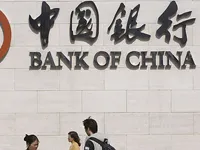
Bank of China gets nod to bring CNY back to Mainland
Move is part of China’s scheme of globalizing the currency as many Chinese and foreign businesses tapping Hong Kong's burgeoning market for renminbi debt.
Bank of China Ltd. has received its first approval to bring yuan it accumulated offshore back to mainland China, in a rare move that is part of Beijing's plan to promote the global trading of the country's currency.
The bank, one of the most active sellers of yuan-denominated debt in Hong Kong, has won the backing of the People's Bank of China, the country's central bank, to bring onshore about 10.5 billion yuan, or about $1.6 billion, it raised overseas, according to people familiar with the matter.
Since last year, a growing number of Chinese and foreign businesses, including banks, property companies and manufacturers, have been loading up on cheap capital denominated in China's currency by tapping Hong Kong's burgeoning market for yuan debt. Today, there is about 125 billion yuan outstanding of so-called "dim-sum bonds," as yuan-denominated debt issued outside mainland China are known, encouraged by the Chinese government as part of its efforts to expand the use of the yuan beyond its borders.
However, any issuer of such debt, regardless of nationality, still needs to get Beijing's approval to bring that money back to the mainland, often a lengthy and cumbersome process. By some estimates, only about half of the funds from dim-sum bonds issued so far have been able to flow back to the mainland, and most of the money raised by Chinese banks in Hong Kong has stayed offshore.
Bank of China, which will invest the repatriated yuan in the higher-yielding domestic bond market, is among the few Chinese banks that also have gained approval from the central bank to put yuan funds to work on the mainland. Earlier this year, China Merchants Bank Co. won similar permission.
But China has been handing out such approvals gradually as it wants a measured growth in offshore trading of the yuan, which until the middle of last year had been confined within China's borders thanks to the country's strict capital controls.
View the full story in The Wall Street Journal.




![Lorem Ipsum [ABF 1]](https://cmg-qa.s3.ap-southeast-1.amazonaws.com/s3fs-public/styles/exclusive_featured_article/public/2025-03/a_hand_pointing_to_a_futuristic_technology_5b87c9d0e3_1.png.webp?itok=2w0y1WhS)


![Cross Domain [Manu + SBR + ABF + ABR + FMCG + HBR + ]](https://cmg-qa.s3.ap-southeast-1.amazonaws.com/s3fs-public/styles/exclusive_featured_article/public/2025-01/earth-3537401_1920_4.jpg.webp?itok=WaRpTJwE)







 Advertise
Advertise

